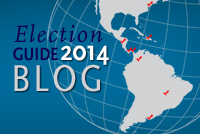2014 Election Blog: What Role Will Latino Voters Play in U.S. Midterm Elections?
Despite growing political clout, Hispanics make up a small percentage of voters in competitive congressional races this year.
With a population of roughly 54 million, Latinos constitute the United States' largest minority group and have become increasingly important as a political force. In 2012, President Barack Obama captured 71 percent of the Latino vote, and high levels of support among Hispanics helped him win key battleground states like Colorado, Florida, and Nevada. But given a number of factors—including voter concentration and turnout—this constituency may not make a large impact during the November 4 legislative elections.
Currently, there are 24.8 million eligible Latino voters in the United States. But Pew Research Center's Hispanic Trends Project estimates the Latino electorate will double in size by 2030, and will account for 40 percent of growth in the national electorate over the next two decades. But the Latino voter's influence at the national level may be limited due to voter concentration in a small number of states and congressional districts. Around 55 percent of Latino voters live in just three states: California, New York, and Texas. Additionally, in 2012, two-thirds of eligible Latino voters lived in what were considered non-battleground states.
This year, party control over the House and Senate will come down to races in states and congressional districts where Latinos do not represent a large percentage of the electorate. Although Latinos represent 10.7 percent of all eligible voters in the United States, according to Pew Research, they make up less than five percent of eligible voters in the eight states with close Senate races considered toss-ups. The exception is Colorado, where Latinos make up 14.2 percent of eligible voters in the state's highly contested race.
The concentration of Latino voters in a small number of House districts—half of all Latino voters live in just 65 of the country's 435 districts—will limit the influence of Latinos on House races, writes The New York Times' the Upshot. Latinos comprise a significant percentage of the electorate in only a handful of this year’s competitive House races, mostly in the West. Democrats in these races could benefit from Latino votes, but only if turnout is high.
However, Obama's September 6 decision to delay executive action on immigration until after the elections could mean some Latinos stay home in November altogether. In June, pollster Latino Decisions asked registered Latino voters how they would react if the president delayed executive action, and 54 percent responded they would be less enthusiastic about voting in November. Plus, 57 percent said they would be less enthusiastic about voting for a Democratic candidate should the president fail to act. “There's always the possibility that in a few key places where there are substantial…Hispanic voters, you might get a stay-at-home effect this time around,” said Roberto Suro, director of Tomas Rivera Policy Institute, which studies demographic diversity issues.
The lack of voter participation presents a challenge, given that turnout among Latino voters already tends to be low compared to other demographic groups. A May 2013 U.S. Census Bureau report found that voter turnout among Latinos in the 2012 presidential election stood at 48 percent, compared to 64.1 percent of eligible white voters and 66.2 percent of eligible black voters. For midterms, the number is lower. During the last legislative election in 2010, only 31 percent of eligible Hispanic voters cast their ballot.







